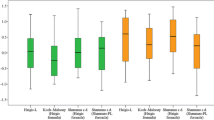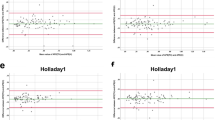Abstract
To compare the accuracy of the predictions of SRK/T and Haigis formulae, incorporating all the parameters calculated using Zeiss IOLMaster Scan, based on partial coherence interferometry, and to analyse the effect of updating or optimisation of the constants on the post-operative result. A retrospective study was done on 51 consecutive patients, who underwent phacoemulsification by a single surgeon with a temporal corneal incision and a standard Alcon Acrysof MA30 implant in the bag. The pre-operative data were measured using Zeiss IOLMaster scan, and the IOL power calculations were done using both SRK/T and Haigis formulae. The final implant power selection was based on SRK/T predictions. The patients were divided into three groups depending on the axial length, and the post-operative results were analysed at 4 weeks. The difference between the predicted value and the post-operative spherical equivalent was calculated for both the formulae, and a paired t test used for significance. The axial length ranged from 20.93 to 25.16 mm. The error for Haigis was less compared to SRK/T overall and SRK/T resulted in an average hypermetropia 0.69 D and Haigis resulted in an average myopia of 0.16 D. The comparison between SRK/T and Haigis and the updated version of both using the paired t test shows a statistically significant difference, the p values being <0.03 and <0.01, respectively. The updated Haigis Formula with the optimised constants was significantly more accurate than SRK/T formula.






Similar content being viewed by others
References
Eleftheriadis H (2003) IOLMaster biometry: refractive results of 100 consecutive cases. Br J Ophthalmol 87:960–963
Schachar RA, Levy NS, Bonney RC (1980) Accuracy of intraocular lens powers calculated from A-scan biometry with the echo-oculometer. Ophthalmic Surg 11:856–858
Gale RP, Saha N, Johnston RL (2004) National biometry audit. Eye 18:63–66
Haigis http://www.augenklinik.uni-wuerzburg.de/uslab/ioltxt/haie.htm XALDON Technologies
Olsen T, Thim K, Corydon L (1991) Accuracy of the newer generation intraocular lens power calculation formulas in long and short eyes. J Cataract Refract Surg 17:187–193
Verhulst E, Vrijghem JC (2001) Accuracy of intraocular lens power calculations using the Zeiss IOLMaster. A prospective study. Bull Soc Belge Ophtalmol 281:61–65
Hoffman PC, Hütz WW, Eckhardt HB (1997) Significance of optic formula selection for postoperative refraction after cataract operation. Klin Monatsbl Augenheilkd 211:168–177
Retzlaff JA, Sanders DR, Kraff MC (1990) Development of the SRK/T intraocular lens implant power calculation formula. J Cataract Refract Surg 16:333–340
Sanders DR, Retzlaff JA, Kraff MC, Gimbel HV, Marsha G, Raanan MS (1990) Comparison of the SRK/T formula and other regression formulas. J Cataract Refract Surg 16:341–346
Richards SC, Oslen RJ, Richards WL, Brodstein RS, Hale PN (1985) Clinical evaluation of six intraocular lens calculation formulas. J Am Intraocul Implant Soc 11:153–158
Hoffer KJ (1980) Biometry of 7500 cataractous eyes. Am J Ophthalmol 90:360–368
Medisoft ophthalmology electronic patient record. www.medisoft.co.uk, Leeds
Holladay IOL Consultant IOL calculation software for ophthalmologists. www.docholladay.com/iolprogram
Hoffer Eye Lab Inc. KDHofferMD@aol.com
Haigis W, Lege B, Miller N, Schneider B (2000) Comparison of immersion ultrasound biometry and partial coherence interferometry for intraocular lens calculation according to Haigis. Graefes Arch Clin Exp Ophthalmol 238:765–773
Findl O, Drexler W, Menapace R, Heinzl H, Hitzenberger CK, Fercher AF (2001) Improved prediction of intraocular lens power using partial coherence interferometry. J Cataract Refract Surg 27:861–867
Acknowledgments
Mr. Alan Rotchford SpR, Queens Medical Centre, Nottingham, for statistical assistance.
Conflict of interest
The authors have no financial or proprietary interests and have not received research funding.
Author information
Authors and Affiliations
Corresponding author
Rights and permissions
About this article
Cite this article
Sharma, R., Maharajan, P., Kotta, S. et al. Prediction of refractive outcome after cataract surgery using partial coherence interferometry: comparison of SRK/T and Haigis formulae. Int Ophthalmol 34, 451–455 (2014). https://doi.org/10.1007/s10792-012-9671-9
Received:
Accepted:
Published:
Issue Date:
DOI: https://doi.org/10.1007/s10792-012-9671-9




